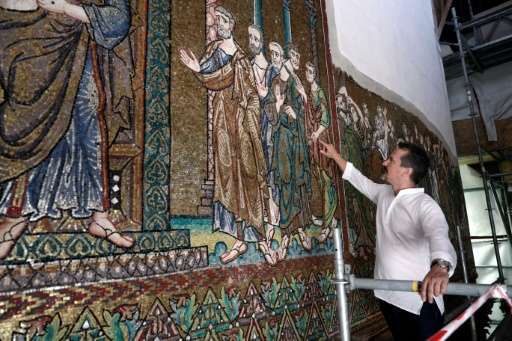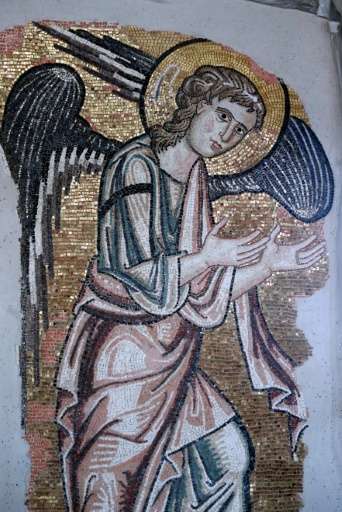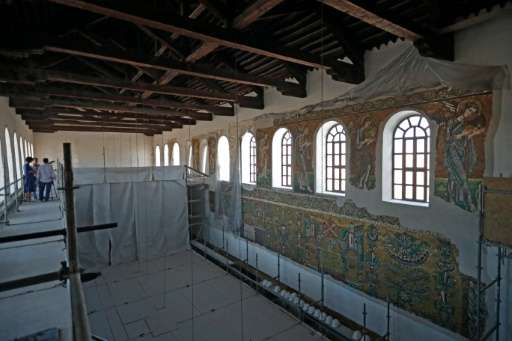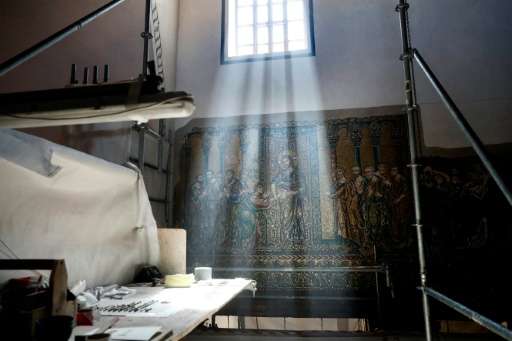Hidden angel mosaic at Bethlehem shrine sees the light

It was hidden for decades at the church on the site where Jesus Christ is believed to have been born until conservationists uncovered it—an ancient mosaic of an angel.
Since 2013, Italian restorationists have been working with the Palestinian government in a mammoth effort to restore the Church of the Nativity in Bethlehem in the occupied West Bank—hailed by Christians as built on the site where Jesus was born.
The roof and windows have been restored and mosaics that had become barely visible over centuries have been painstakingly brought back to full colour, one tiny tile at a time.
In the course of the work they were surprised to uncover an angel that had been hidden under plaster for decades.
With thermal cameras, similar to those used by the military at night, they scanned the walls to see if there was anything behind them, said Giammarco Piacenti, CEO of the Piacenti restoration company which is leading the work.
"In that part it was completely different, you could see the angel. We said 'what is this? It can't be an angel'," he told AFP.
After peeling back the plaster they uncovered the mosaic, bringing the number of angels in the church to seven.
Its outstretched hand is pointing in the direction of the cave where Jesus is believed to have been born.

And the discovery has already spawned a myth after the excavator who discovered it, who happened to be Piacenti's niece, became pregnant shortly afterwards.
"All the family speak about how the angel (blessed her)," he laughed.
The church, which sees more than two million visitors on good years, was originally built in 339 AD but rebuilt in the sixth century after being destroyed in a fire.
Infighting between the three churches involved in running the site had prevented redevelopment, with the last renovations taking place in 1478, according to Piacenti.
Limited funding
"From a historical, artistic and spiritual point of view, it is everything," said Piacenti. "The centre of the world—this is everything."

Issa Hazboun, a Christian Palestinian engineer and a member of the project construction management team, says the redevelopment of the site is a source of "pride" not just for him but for Christians across the Middle East.
Christians have been targeted in Syria, Iraq and other parts of the region in recent years, with millions fleeing their homes.
Palestinian Christians, too, complain of ill treatment by Israel, and Israeli forces recently began extending a separation wall through the West Bank in the area near Bethlehem.
"Of course (Christians across the region) will be very happy—the birthplace of the Messiah is being renovated," Hazboun told AFP. "We are happy they are going to see how the work is going."
The ongoing restoration, however, is threatened by limited funding, with the Palestinian authorities looking for a further 7.5 million euros ($8.3 million) on top of the nearly 10 million euros ($11 million) already received.
There are 50 sixth-century columns to be restored, most of which have barely visible paintings of crusader figures, with wealthy donors being asked to "adopt a column", Piacenti said.

Ida Molinaro, a restorer, is painstakingly bringing back the colour to one column. Each costs 50,000 euros ($55,000) to restore.
Because of the religious importance of the site, it has not been closed down during the work, so renovators have to work around throngs of tourists and monks, a situation she admits can be tough.
"Living in a restoration site 24 hours per day in contact with tourists and priests of different religions is challenging, both psychologically and in terms of work, but at the end it gives you a lot," Molinaro said.
If the necessary funding is found, the renovations are due to be completed in 2018.
© 2016 AFP


















